The year 2019 is a particularly good one in terms of anniversaries of historically significant timepieces. Perhaps the best known of these is the commemorative edition of the legendary Omega Speedmaster that took part in the first moon landing 50 years ago (see 7 NASA Astronauts Wearing Their Gold Omega Speedmaster Professional Apollo XI Limited Editions: Celebrating 50 Years Of Man On The Moon).
Nineteen sixty-nine also marked the introduction of the world’s first automatic chronographs, which were presented by five major industry players led by Zenith with its El Primero – one of the most famous of these and additionally the first able to measure one-tenth of a second with state-of-the-art integrated movement design.
Seiko also came out with its 5 Speedtimer automatic chronograph that year, which likewise boasted an integrated chronograph.
And, of course, there was the illustrious group of brands comprising Breitling, Heuer-Leonidas, and Hamilton-Büren who, under the name “Project 99,” had secretly teamed up to develop a modular automatic chronograph movement christened “Chronomatic Calibre 11” that each brand could use (and would go on to name differently).
The fact that it took all of them several years until their prototypes were ready – Seiko and Zenith both had begun their developments in 1962 with Zenith hoping for it to be ready in time for the manufacture’s centenary anniversary in 1965 – indicates just how challenging it was to combine the self-winding mechanism with a chronograph.
The main issue being that a complex chronograph mechanism requires significantly more power than simply displaying the time, thus requiring a more powerful winding mechanism.
Watchmakers also had to break new ground in order to combine the two complex elements, integrating many additional components (most obviously the rotor) within the small dimensions of a wristwatch case.
The achievement of a working automatic chronograph prototype was set to gain valuable market shares and the promise of great success for these brands.
Viewing 1969 with the 20/20 vision of today’s perspective, the success of the automatic chronograph could have been called the pinnacle of the centuries-old Swiss watch industry before it was nearly decimated by the much more precise and much cheaper quartz technology, which also debuted in 1969 with the advent of the Seiko Astron.
The story of the automatic chronograph is one of the most exciting in the history of timekeeping – almost as suspense-packed as a thriller, at least to watch enthusiasts. It is also proof positive of the creativity that watchmakers apply to their crafts, for each of the parties involved managed to come up with unique approaches.
World premier: Heuer’s hip-yet-square Monaco
Let’s dash back to 1969, when timing specialist Heuer (later becoming TAG Heuer) once again pushed the limits of stopwatches for the wrist.
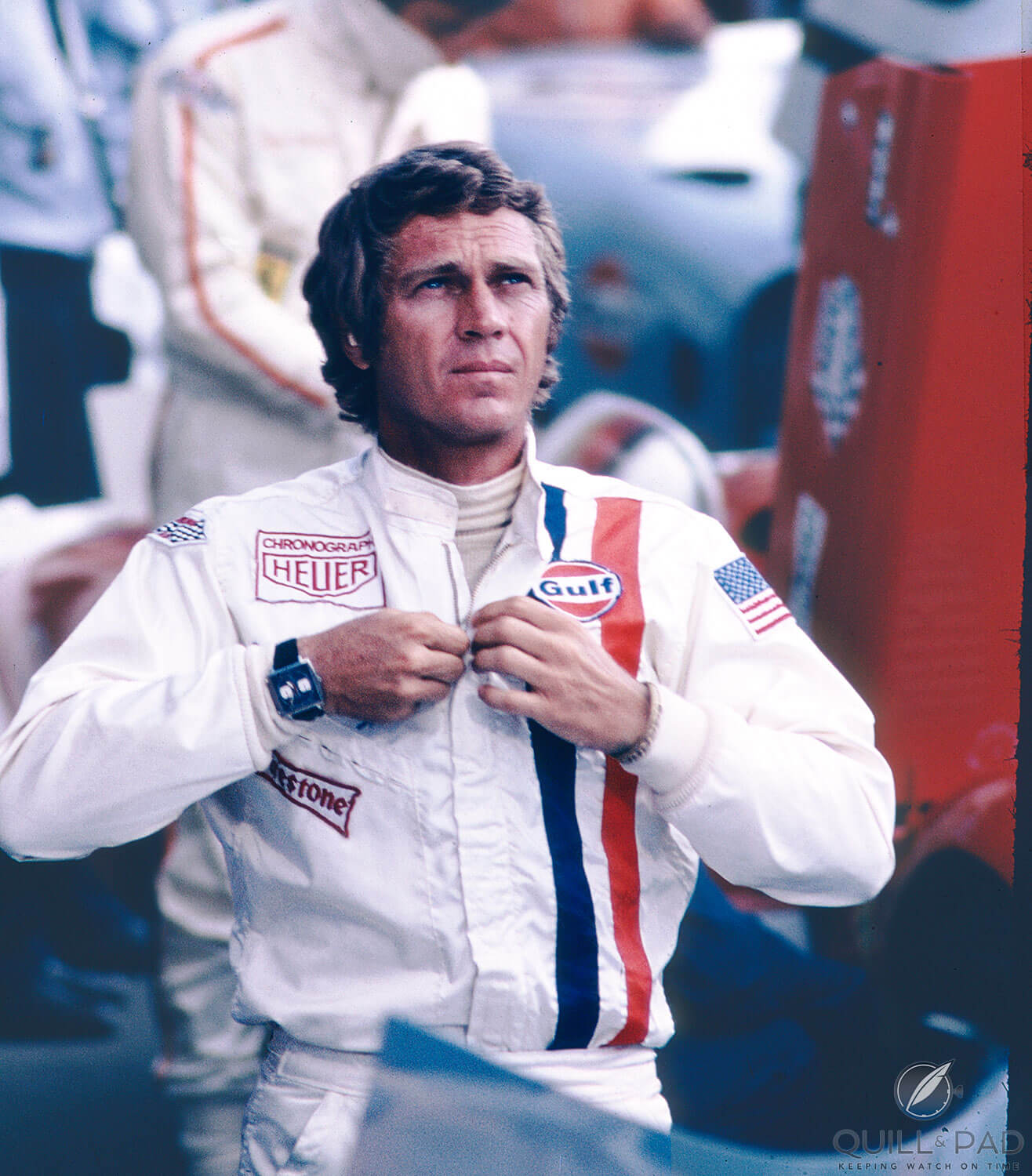
Steve McQueen wearing a TAG Heuer Monaco in the film ‘Le Mans’
Heuer’s Monaco model, named for the Grand Prix Formula One race held annually on the principality’s “circuit” (aka city streets), was both powered by the above-mentioned Caliber 11 and featured the first non-round case with guaranteed water resistance. The waterproof square case was a sensation in itself, marking a true first in horology as until the Monaco anything other than a round form had proved too challenging to reliably seal.
Until the launch of the Monaco only round cases were guaranteed water resistant. Heuer literally squared the circle of case production with the help of Swiss case manufacturer Piquerez, who had developed a new gasket system. Four notches clicked into place on the case back where tension generated a compressed seal.
Dare to be square: TAG Heuer Monaco
On March 3, 1969 when the TAG Heuer Monaco was introduced simultaneously in Geneva and New York to much fanfare alongside Breitling’s Navitimer Chronomatic 11, it gave the watch world much to talk about.
The Monaco’s bold, square case, the deep-blue dial with likewise square chronograph counters and elongated hour indexes, and the crown placed on the left side in order to show that this watch didn’t require winding stood out from the typical offerings of Switzerland’s timepieces. While some strongly disliked the unusual appearance, others were entirely taken by it, and the Monaco quickly gained momentum.
Its refreshing charisma appealed both to the horologically interested and lovers of daring design.
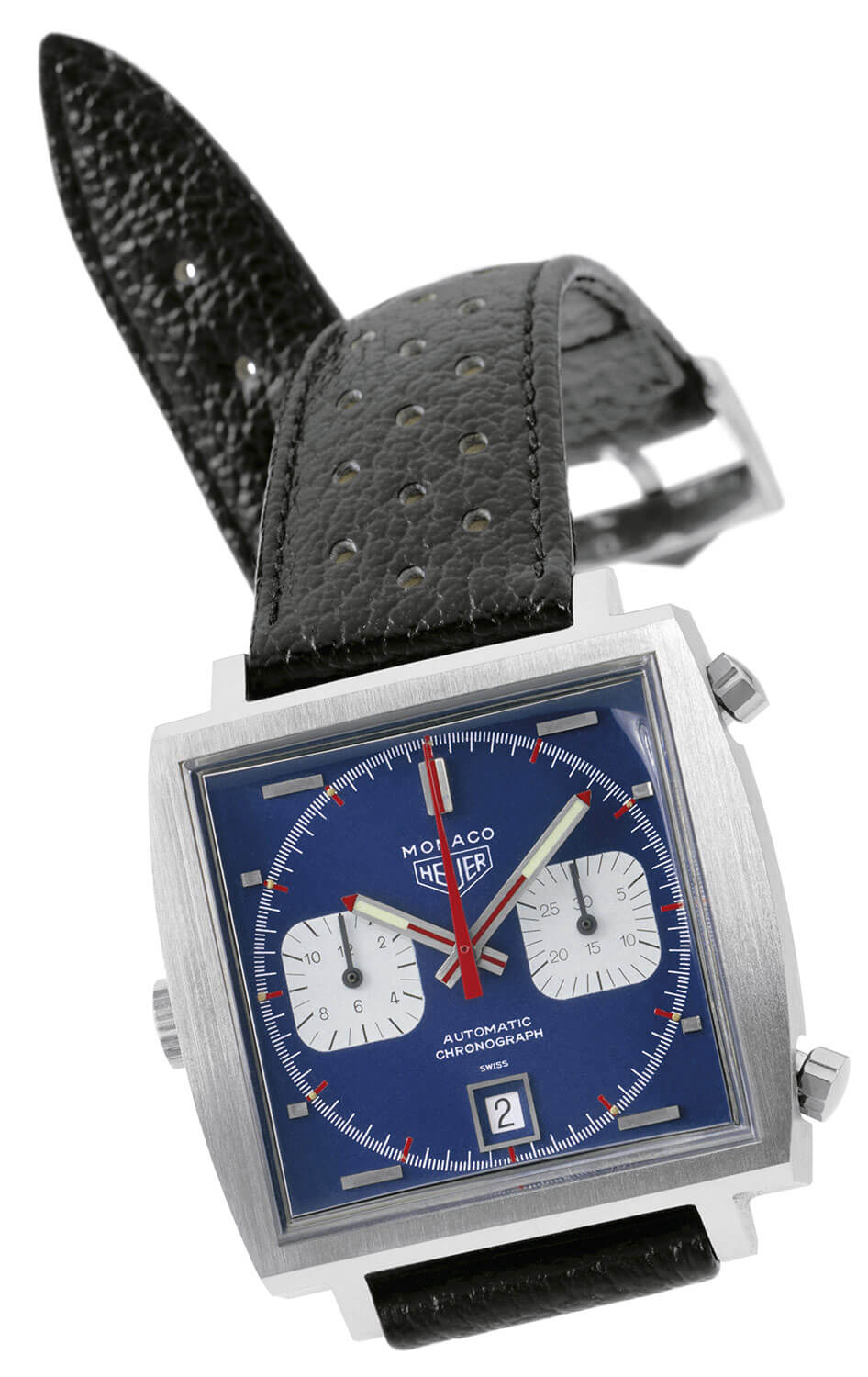
Heuer Monaco chronograph from 1969
The fact that it gained “legend” status within only two years can be attributed to Jack Heuer’s considered marketing strategies – one of which was to have his company become the first watch manufacturer to sponsor a race car driver.
Heuer chose Jo Siffert, one of the best drivers of his time (and who Heuer allegedly paid in watches).
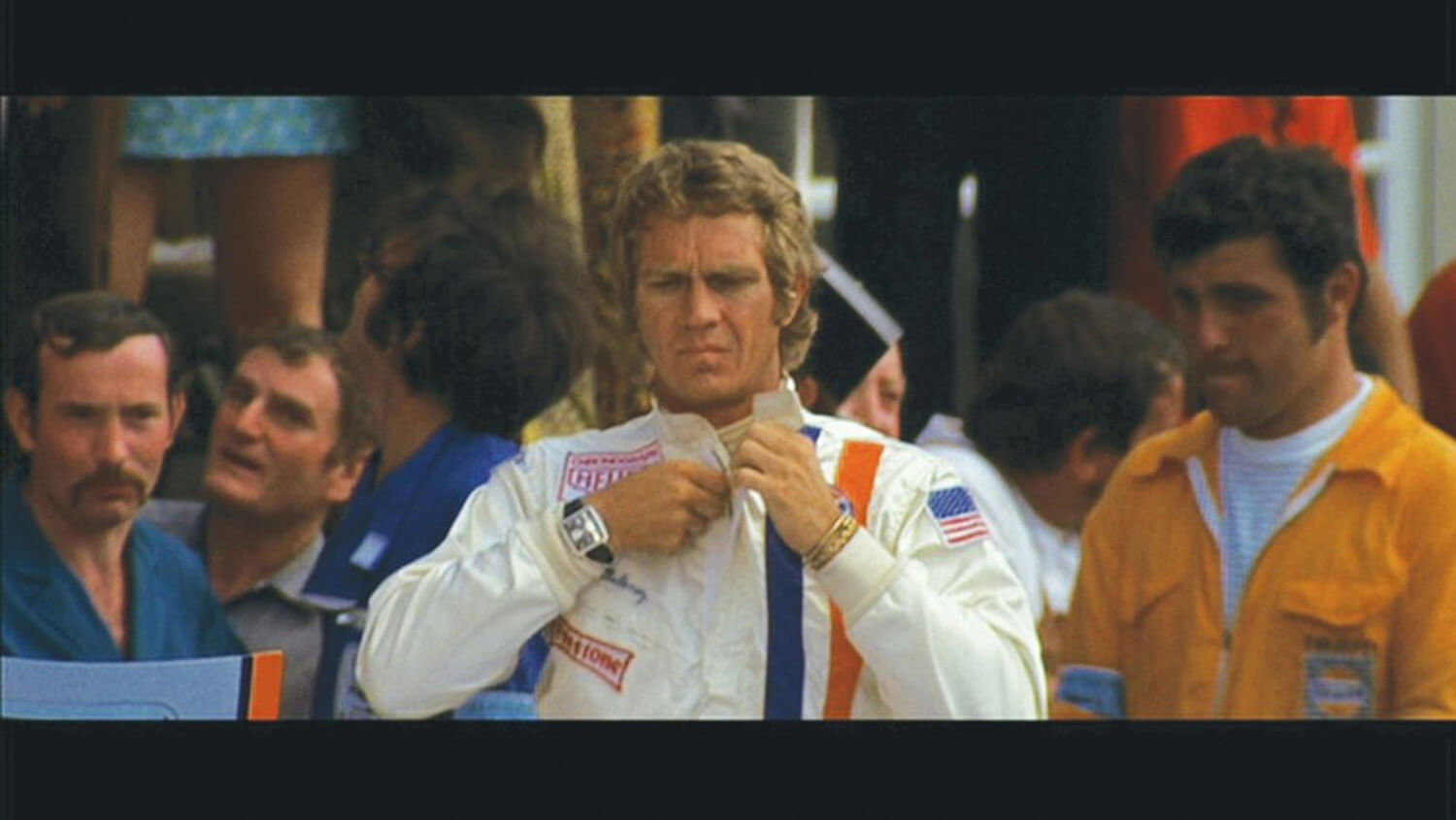
Steve McQueen wearing a Heuer Monaco on the set of ‘Le Mans’ (photo courtesy www.liveauctioneers.com)
The sponsoring came back a hundredfold and more when Steve McQueen chose to emulate Siffert for his lead role in Le Mans, the world-famous racing moving appearing in 1971 – including a racing suit prominently displaying the Heuer logo.
The story of McQueen’s choice to wear the Monaco is well documented in The Real Story Behind Steve McQueen’s Heuer Monaco: Exclusive Interview With ‘Le Mans’ Property Master Don Nunley.
Legend has it that McQueen loved his Monaco so much he wore it privately, even after shooting on the film was completed. Either way, the king of cool certainly had a hand in the immense popularity of the timepiece.
Thanks to its unique history with more than one first and a brave design, the Heuer Monaco has ranked among the most sought-after timepieces ever since.
Many Monaco fans – including me – had hoped for a great and possibly authentic commemorative edition to be introduced at Baselworld 2019, probably in a square case with a bright blue face and the familiar red chronograph hands and accents.
Sadly, TAG Heuer didn’t live up to fan expectations, and I was really disappointed when I did not spot a new Monaco among its new pieces at the world’s largest watch fair, which notably featured the new Autavia Isograph.
The Heuer Monaco’s race through five decades
However – drum roll, please – during the 2019 Monaco Grand Prix the brand announced a book dedicated to the model’s multifaceted history and five limited editions to be launched throughout the year, each with a unique take on one of the Monaco’s five decades in existence commemorating the timepiece’s fiftieth anniversary.
Three new Monaco models have been released to date.
TAG Heuer Monaco Calibre 11 Limited Edition 1969–1979: earthy hues and some Geneva waves
The celebrations were kicked off at a truly worthy site: the Monaco Formula 1 Grand Prix. It was here on May 26, 2019 that TAG Heuer’s CEO Stéphane Bianchi presented the first of the five limited editions powered by the brand’s modern version of Caliber 11.
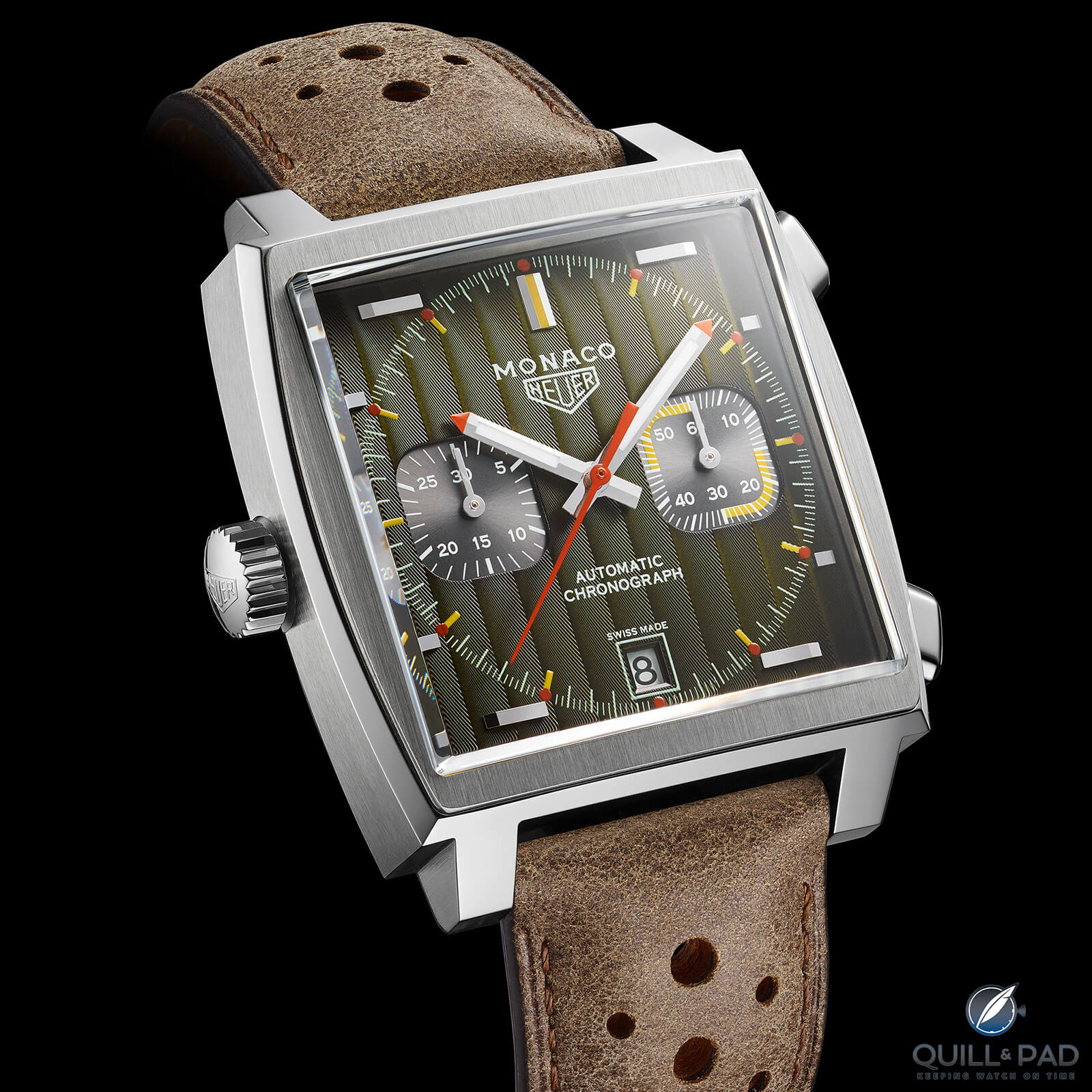
TAG Heuer Monaco Calibre 11 Limited Edition 1969–1979
The TAG Heuer Monaco Calibre 11 Limited Edition 1969–1979 encapsulates the bold style of fashion in the early 1970s. It features a very cool brownish-green dial with an eye-catching vertical Geneva wave pattern. Unusually placed on the dial – this engraved pattern is usually found on the movement – it serves as the perfect backdrop for the two rounded square chronograph counters in black gold-plated sunray finish. The brown and dark yellow accents likewise fit into the 1970s color scheme.
As with all of the new limited Monaco editions, the back is engraved with the original “Monaco Heuer” logo as well as “1969-1979 Special Edition” and “One of 169.”
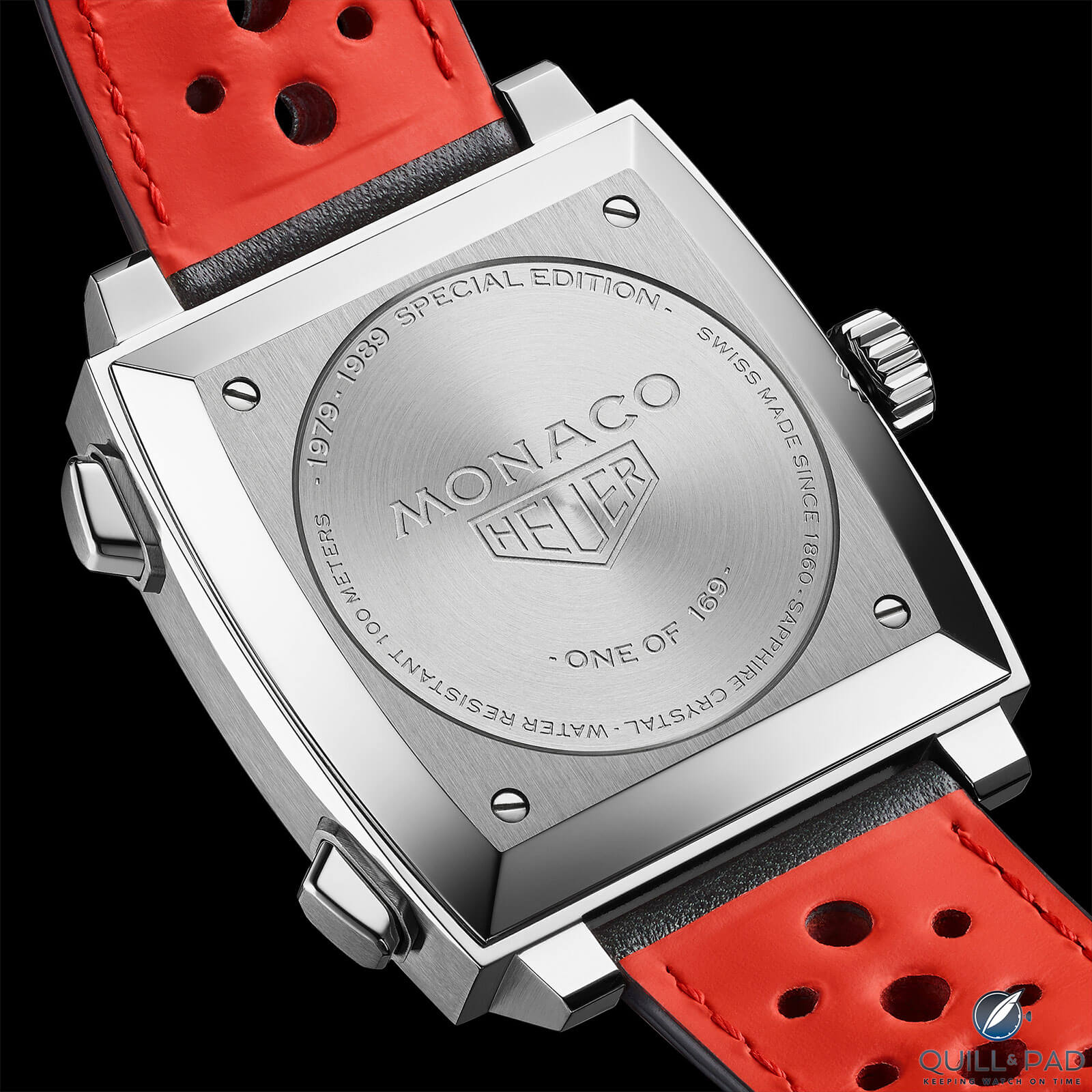
Engraved back of the TAG Heuer Monaco Calibre 11 Limited Edition 1979-1989
TAG Heuer Monaco Calibre 11 Limited Edition 1979–1989: radiant red and a fine sunray finish
It didn’t take TAG Heuer long to launch the second edition a month later, which is dedicated to the colorful 1980s.
Once again, the brand chose a history-charged venue: on June 15, 2019 the brand presented the Monaco Calibre 11 Limited Edition 1979–1989 in Le Mans.
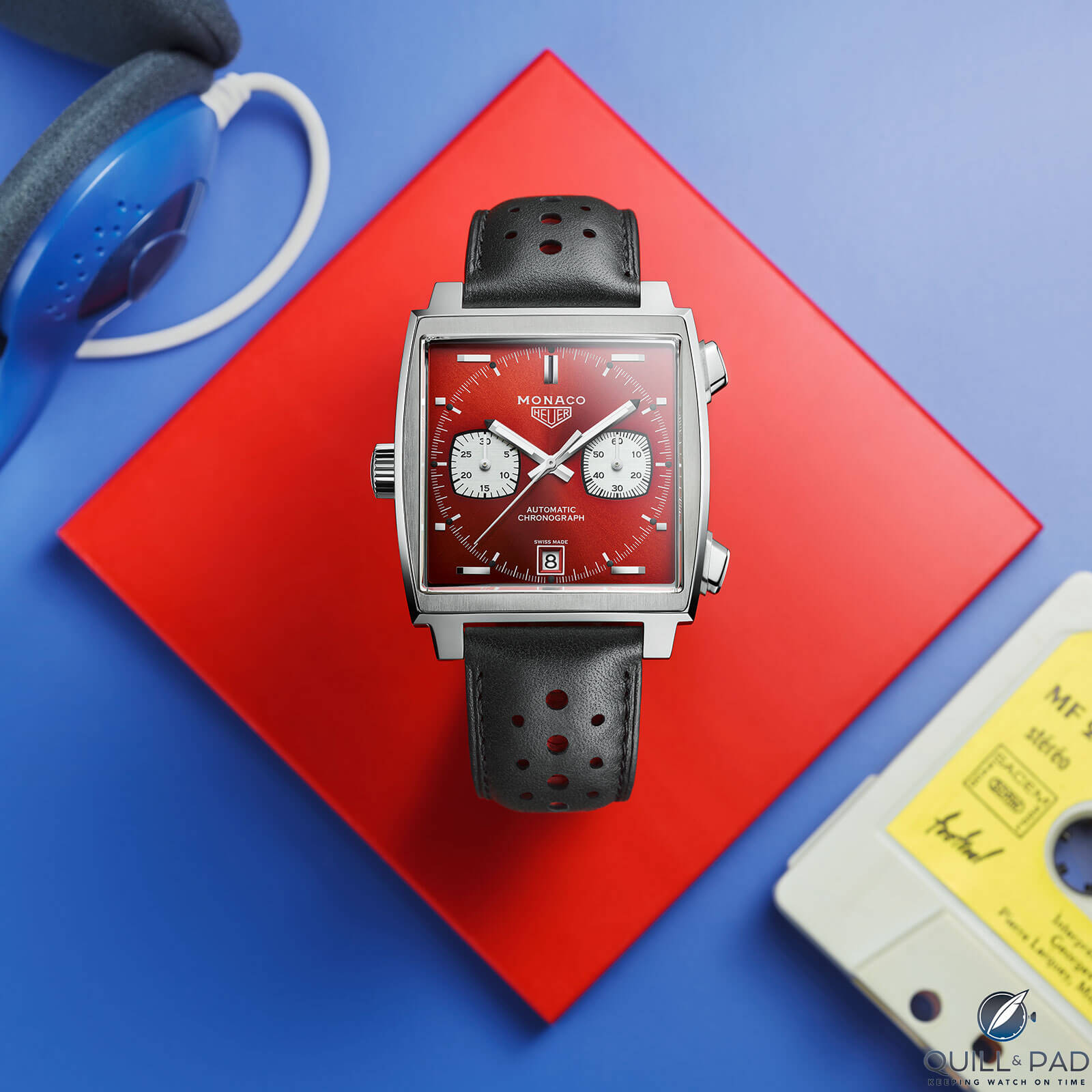
TAG Heuer Monaco Calibre 11 Limited Edition 1979-1989
And while I already really liked the seventies edition, I was even more attracted by the sheer beauty of the second edition’s bright red dial.
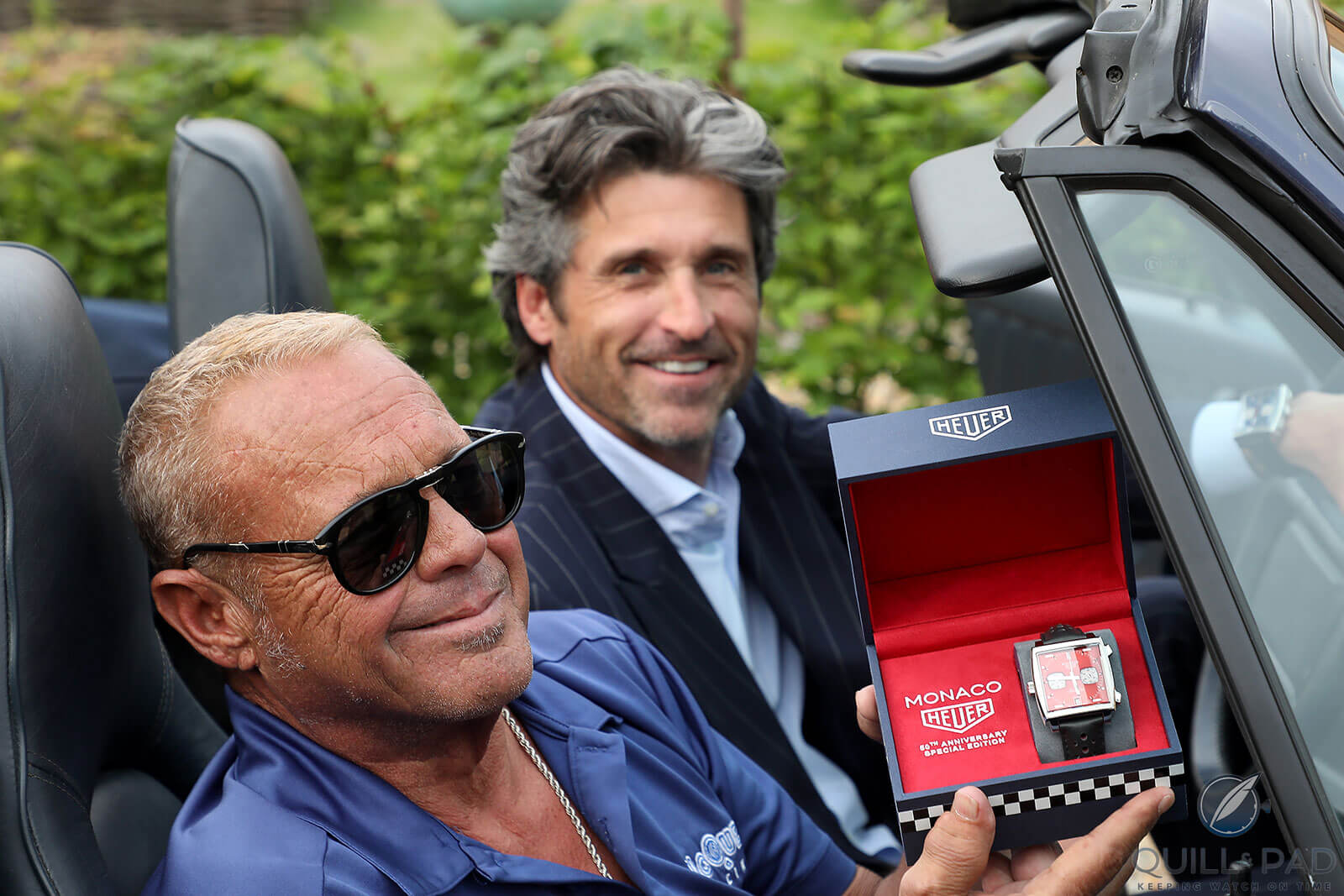
Chad McQueen and Patrick Dempsey in Le Mans with a TAG Heuer Monaco Calibre 11 Limited Edition 1979-1989
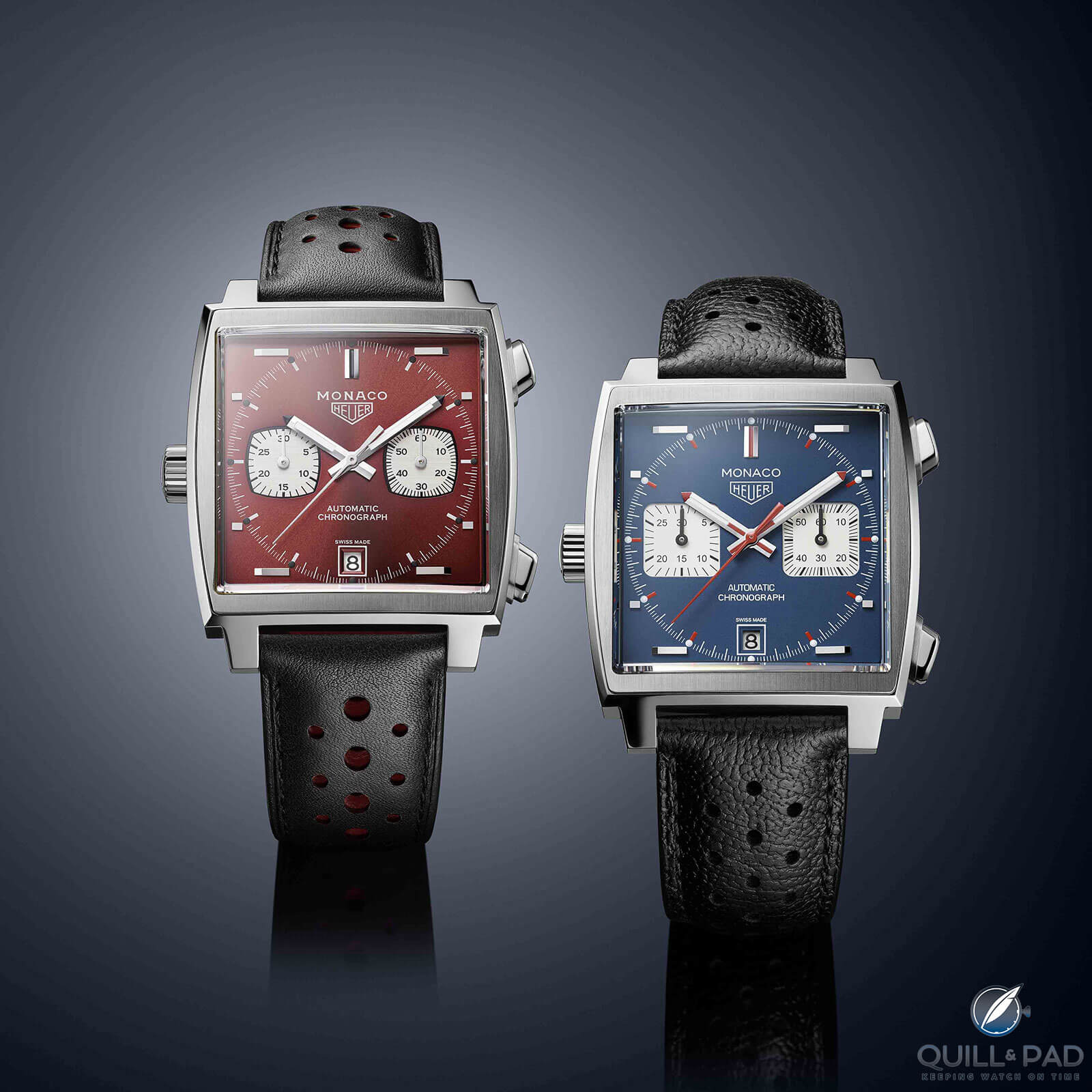
TAG Heuer-Monaco Calibre 11 Limited Edition 1979-1989 (left) plus original 1969 model (right)
As the original blue dial springs to mind when you think of the Monaco, a different color, particularly a radiant one like red, can make such a difference.
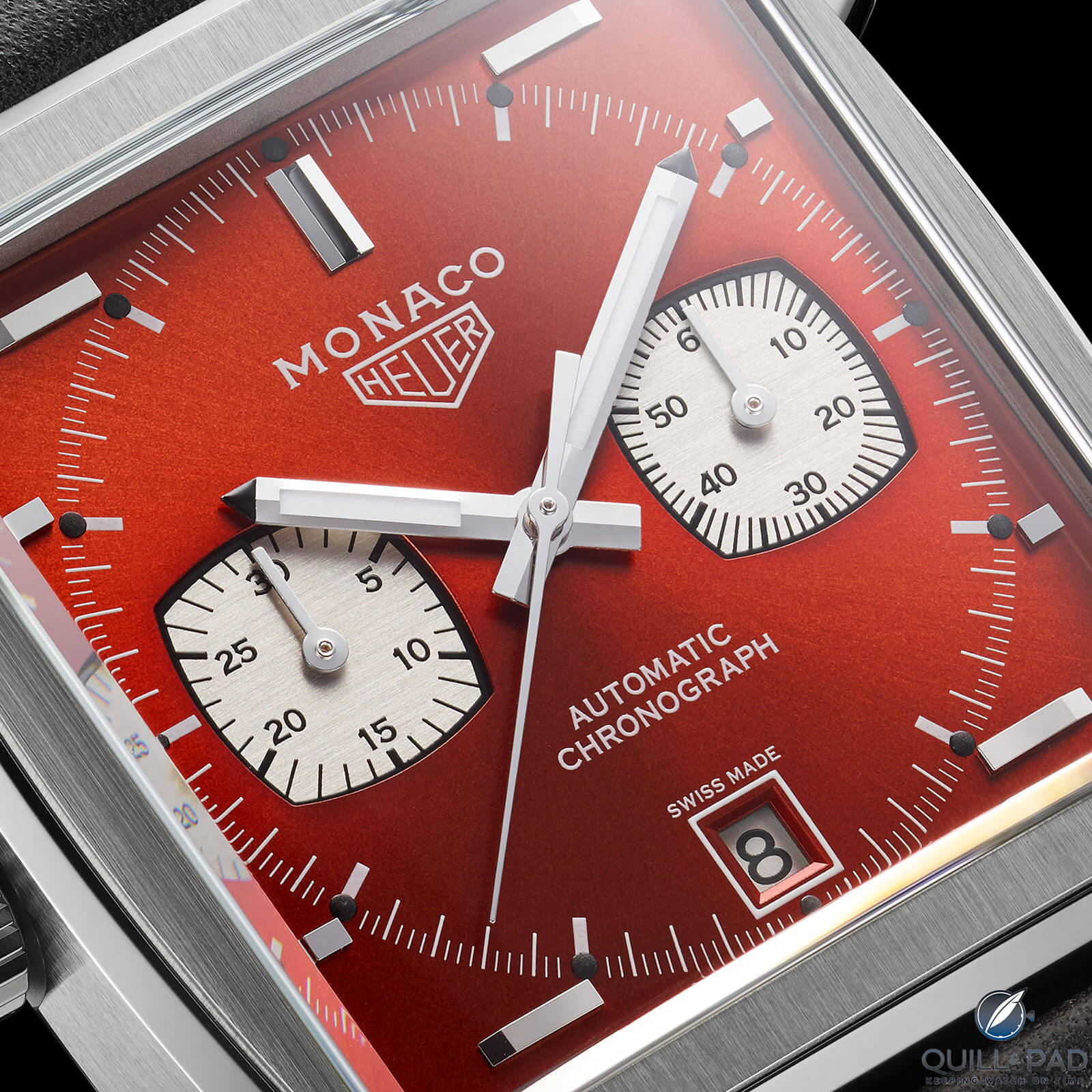
Dial of the TAG Heuer Monaco Calibre 11 Limited Edition 1979-1989
And it goes exceptionally well with the silver chronograph counters outlined in black and the color-coordinated hour indexes.
TAG Heuer Monaco Calibre 11 Limited Edition 1989–1999: elegant gray grainy surface
The third time is a charm and all good things apparently come in threes: although I would not have expected it, I like the third edition even better than the two previous ones.
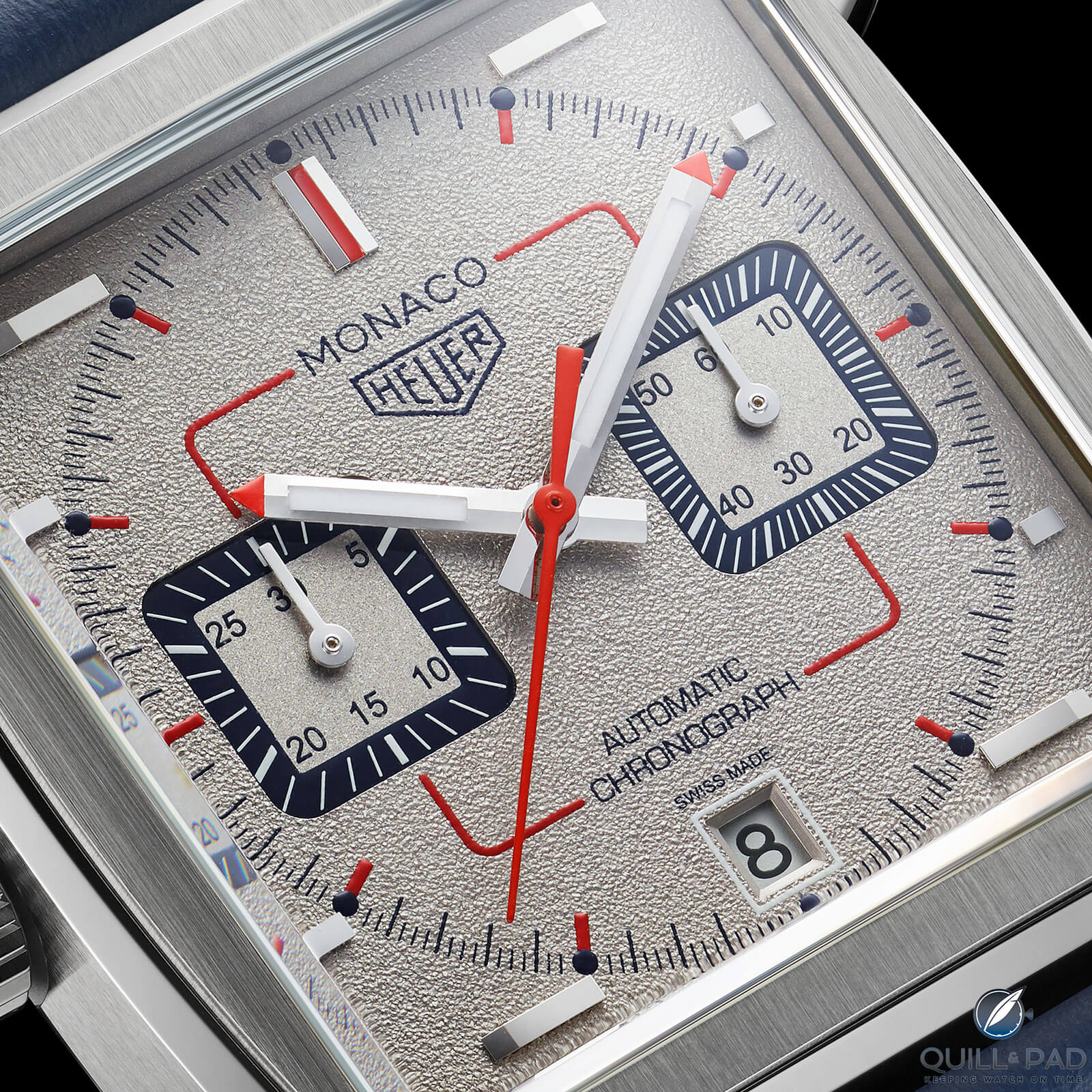
TAG Heuer Monaco Calibre 11 Limited Edition 1989 – 1999
As expected, it is a tribute to the 1990s – and what a gorgeous one. Its dial shows the same attention to detail. sporting a grainy surface meant to create an industrial style.
The color scheme comprising light grey, dark blue, and expressive red is very tasteful. If I were to buy a Monaco Calibre 11 Limited Edition, I would go for the light grey model, although that’s not the only one I like.
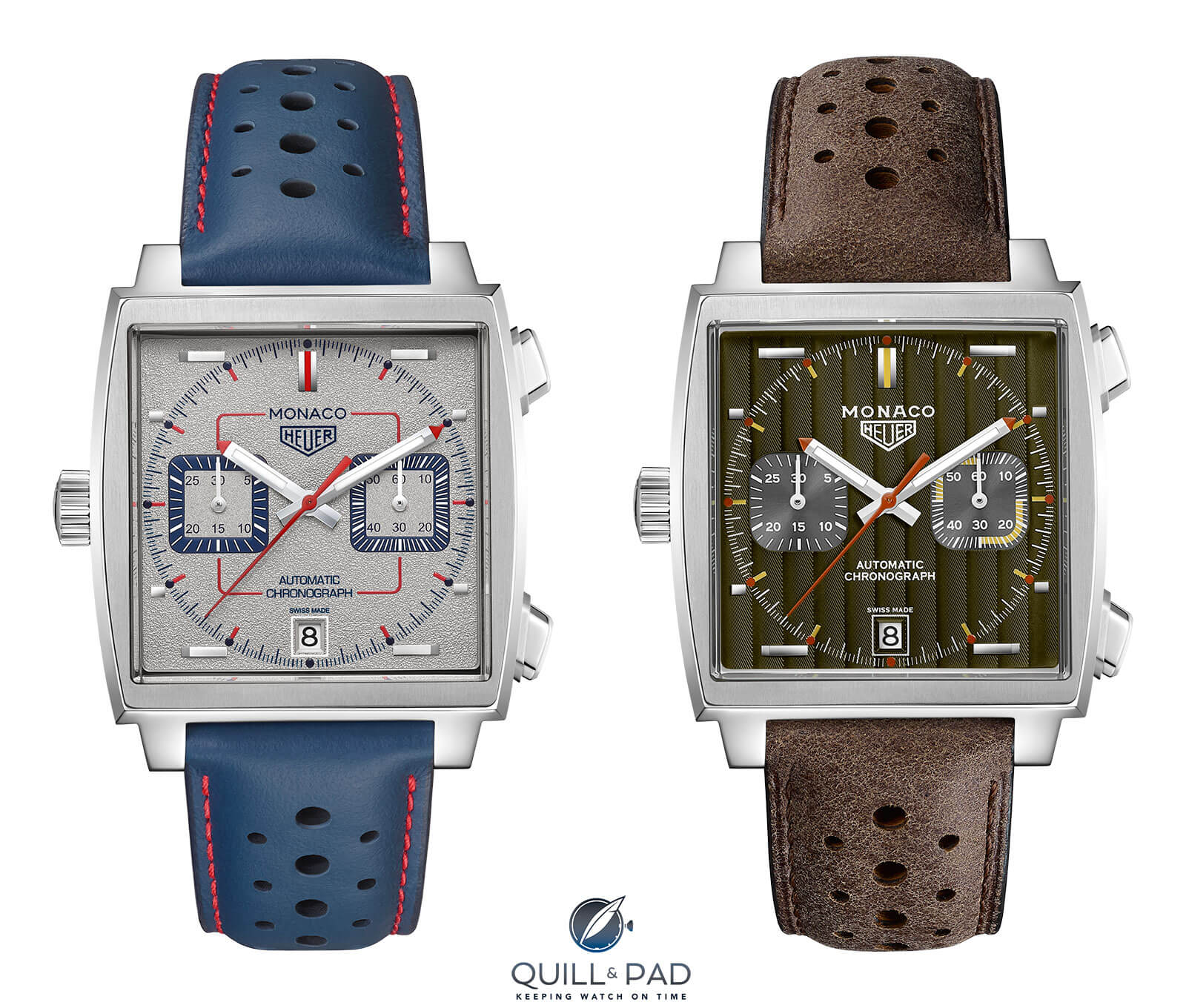
As different as the three versions are, each one captures the unique charisma of a style icon that is as fresh today as it was half a century ago.
For more information, please visit www.tagheuer.com/en-us/watches/monaco-watch.
Quick Facts TAG Heuer Monaco Calibre 11 Limited Edition 1969–1979
Case: 39 x 39 mm, stainless steel
Movement: automatic Caliber 11 (based on Sellita SW300), 28,800 vph, power reserve 40 hours
Functions: hours, minutes, seconds; date, chronograph
Limitation: 169 pieces
Price: $6,550/€5,950/CHF 6,400
Quick Facts TAG Heuer Monaco Calibre 11 Limited Edition 1979–1989
Case: 39 x 39 mm, stainless steel
Movement: automatic Caliber 11 (based on Sellita SW300), 28,800 vph, power reserve 40 hours
Functions: hours, minutes, seconds; date, chronograph
Limitation: 169 pieces
Price: $6,550/€5,950/CHF 6,400
Quick Facts TAG Heuer Monaco Calibre 11 Limited Edition 1989–1999
Case: 39 x 39 mm, stainless steel
Movement: automatic Caliber 11 (based on Sellita SW300), 28,800 vph, power reserve 40 hours
Functions: hours, minutes, seconds; date, chronograph
Limitation: 169 pieces
Price: $6,550/€5,950/CHF 6,400
You may also enjoy:
Steve McQueen, The Set Of ‘Le Mans,’ And A Surprising Cartier Tank
TAG Heuer Autavia Isograph: Carbon-Composite High-Tech Hairspring For All





















































Leave a Reply
Want to join the discussion?Feel free to contribute!